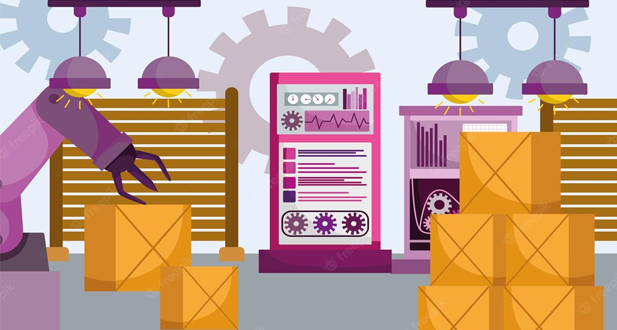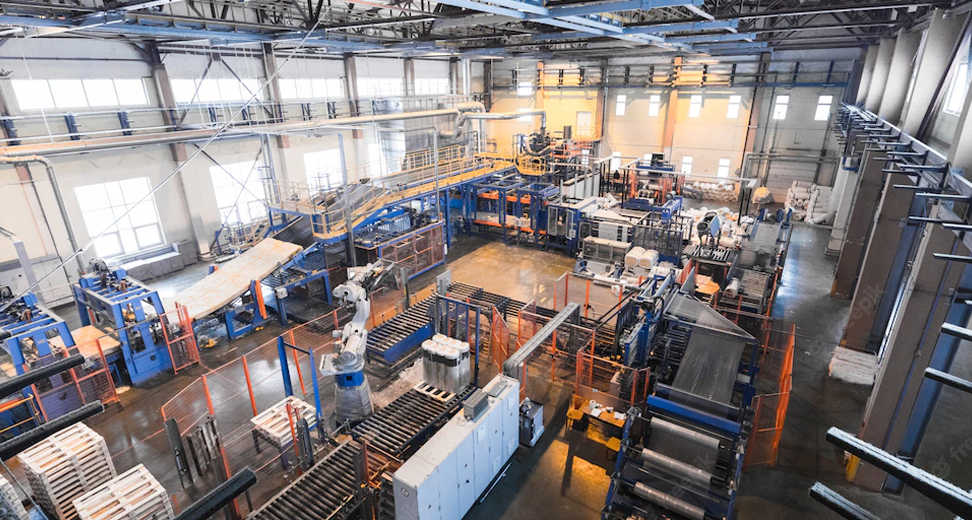Odoo Manufacturing Module is made up of a variety of features and procedures that can assist you to learn how to utilize it for different types of business. We will discuss numerous advantages and features provided by the MRP module of the Odoo ERP software in this tutorial. Implementing a manufacturing ERP can be challenging if it needs to be carefully thought out with a fantastic Odoo Vendor who is knowledgeable about a wide range of Odoo MRP apps. The reason Odoo ERP MRP module is the ideal choice for small and medium-sized manufacturing enterprises is that it is You can choose between open-source software, which is less expensive, and the Enterprise edition, which has numerous features that a manufacturing company would need.
Beginning with raw ingredients, which are transformed into different bills of materials and then manufactured as a final product, the manufacturing process begins. A single product may include numerous Bills of Materials, each of which needs to be handled effectively. Odoo ERP software is capable of managing your manufacturing process effectively. The Odoo Manufacturing ERP software enables you to manage intricate production flows, BOMs, MO planning, work order tracking, and other processes. You can quickly construct MO with the Odoo Manufacturing module and manage them during the various production phases.
Complex manufacturing processes may also be managed with ease; one can also tailor the manufacturing process based on the needs of the organization or through the use of work centers and other accessible Odoo routing concepts. For small and large manufacturers, the Odoo manufacturing app is affordable and easy to use. Odoo has a robust MRP module, a module for managing warehouses, and a module with a tonne of functions. In addition, there are numerous other Odoo Apps that a Manufacturing unit can use in accordance with their needs through straightforward setup or customization.
Features of Odoo Manufacturing
The process of turning unfinished materials or components into finished items or products is known as manufacturing. A business that manages a lot of manufacturing orders must efficiently track each manufacturing order. One can manage the manufacturing processes with ease and without difficulty if they have an effective and reliable ERP. To handle the industrial sector successfully and efficiently, Open ERP/Odoo has a number of functionalities. The end-user can manage bills of materials, plan manufacturing orders, track work orders, etc. with the aid of the Odoo Manufacturing ERP Software.
Manufacturing with Odoo has a pretty straightforward operating procedure. With the aid of Odoo Manufacturing, end users may create manufacturing orders for products, transit them through various production line phases, and finish production. Using WorkCentre and other routing principles, one can also use Odoo Production to tailor the manufacturing process to your company’s processes. At every point in the production process, you may easily handle “Scraps” and, if necessary, “Unbuild” a manufactured good. For efficient management of the complete process, a company may assign various level users to oversee the full manufacturing operation.
Comparing the Odoo manufacturing module to other ERP solutions reveals a number of special capabilities that are exclusive to Odoo. For instance, while Odoo implements all of these features, SAP ERP does not offer features like byproducts, routing capability, single BOM for multiple product variants, MRP II scheduler, Master production scheduler, Kanban Planning, Production Calendar, Backward scheduling, Work orders, Repair, etc. Additionally, features like Equipment/Machine Management, Work Instructions on Work Orders, Maintenance Requests from Shop Floor Terminal, Production Calendar, etc. give Odoo the edge over Microsoft Dynamics.
Let’s look at each feature in Odoo Manufacturing one by one.
Control
The manufacturers may access the company information with just one click thanks to the adoption of Odoo Manufacturing. It enables top management representatives to manage and track all crucial business data in real time and turn it into business expansion.
- Manage your products into assembly lines or manual assembly for manufacturing orders.
- Work orders start manufacturing the components required for your products’ final assembly.
- Manage repairs of goods covered by warranties or provided as a service with repair orders.
Arrange and prepare
It offers better demand planning, more precise production scheduling, better coordination of distribution networks, and better control over component inventory, all of which help businesses increase product on-time delivery, a crucial performance indicator for manufacturers. Manufacturers will have a lot of inventory coming in and going into production, especially if they are engaged in mass production. With the use of ERP, manufacturers will be able to keep track of all of this inventory, including its features, quantities, locations, etc.
Manufacturing strategy: View your entire planning clearly and easily reschedule manufacturing.
- Set up work orders: Utilize all resources at your disposal and make a production plan.
- Manage the materials bill: Observe the production and stock levels of the products.
- WorkCentre Capacity: The MRP II scheduler uses WorkCentre’s capacity and schedules.
Specify Modular Master Data
Routing must be carefully established before manufacturing can begin. Routing is essentially the process of building the product utilizing the components listed in the BOM. Multiple stages and different work centers—the people/locations where the actual production activity happens—might be involved. What Odoo Manufacturing does is:
Make multi-level bills of materials by nesting one bill of materials inside another to construct the product’s component parts.
- Alternative route: In order to order your production based on the chosen routing, create new work order routines.
- Version updates: Give your products room to grow and include custom options when taking orders.
- Create a phantom bill of materials (BoM) to produce and market things as kits or to construct replacement parts.
Superior
Before production, in the middle of the manufacturing process, or at the end, Odoo Manufacturing inspects quality checks for acquired materials. When problems arise, the manufacturing ERP’s quality check systems help in locating and fixing the issue, improving the product’s quality and customer satisfaction.
- Control Points: Automatically start manufacturing department quality checks.
- Quality Checks: Use checks to quickly implement your statistical process control.
- Utilize the Kanban view of quality alerts to organize your work.
Maintenance
A manufacturing ERP can also enable maintenance requests for fixes and other repairs. These directives will group requests and assign them to the maintenance crew. By calculating statistics like the average time to failure, ERP systems like Odoo can also automate preventative maintenance—regularly planned maintenance on things to make them less likely to fail.
Preventive Maintenance: Based on KPIs, automatically initiate maintenance requests.
- Corrective Maintenance: The control center panel can be used to initiate corrective maintenance.
- Calendar: Use a calendar to schedule maintenance tasks.
- Get a complete computation of all maintenance statistics: MTBF
Tablets: Place tablets at each workstation to easily arrange employees’ workloads. Register productions, and look up lots, goods, or serial numbers to keep track of production.
- Worksheets: Directly display worksheets with operator instructions on the WorkCentre.
- Misc. Operations: Utilize the WorkCentre to do checks, create quality warnings, and scrap products.
- Use alerts to show the operator changes or quality assurance inspections.
The qualitative measures that the Odoo BI engine might recommend to you in the manufacturing module include getting a thorough analysis report on your production line, analyzing the performance of your work centers and production, planning alternative production strategies, etc.
How Odoo is Useful in the Manufacturing Sector
Abstract
Manufacturing is the process of turning raw resources into finished goods. ERP (enterprise resource planning) software can be used to organize all of the intricate processes that go into manufacturing
Odoo is one of the various ERP options available on the market. The end-user can manage the complexity of products with the help of the Odoo Manufacturing ERP Software by organizing manufacturing orders, tracking work orders, and more.
The administration of inbound/outbound activities gets more scattered as manufacturing businesses expand. Odoo ERP is a centralized control system that efficiently manages company operations for industrial enterprises.
For manufacturing industries, Odoo ERP assists with the automation of processes including material sourcing, purchasing, inventory, orders, accounting, invoicing, and human resource management.
Odoo offers a variety of modules for efficient business management. You can create invoices, handle material handling, track product items, and do a lot more with the aid of the Odoo Manufacturing Module.
Like every other industry, manufacturing faces a number of difficulties. You can overcome these obstacles and manage your business workflow with MRP or Odoo Manufacturing.
Let’s investigate the typical issues facing the manufacturing sector.
Seven Issues Facing Manufacturing Sectors
- Demand PredictionThe primary technique used by manufacturers to accurately determine the right supply rate and develop the necessary resources to reduce costs is demand forecasting. However, because of a variety of factors, it can occasionally be difficult to determine the actual demand for a month or year. The demand could be high or low as a result of several modifications to each characteristic. Due to inaccurate demand predictions, calculating how many things to produce is a big challenge for any manufacturing sector.
- Taking Care of InventoryThe ROI (return on investment) can be impacted by manually managing an inventory because of inaccurate data, storage issues, and bad judgment. A manufacturer may have shortages and other issues if they have trouble managing their inventory.
- Cost Reduction And Improved EfficiencyOne of the simplest methods to double the earnings is to lower manufacturing costs while maintaining a strong, efficient supply chain. To cut costs and boost efficiency, industrial companies must adopt automation in management and operations.
- Upkeep of Machine EfficiencyThe effectiveness of a company’s machinery needs to be managed. Any production process for a product must include machine maintenance. Businesses won’t be able to operate at full capacity if their equipment is worn out. Their production capability will gradually decrease. As a result, the manufacturing organization must frequently carry out machine maintenance operations. Regular maintenance causes output delays, which negatively impacts the industrial industry as a whole.
- The Total Cost Of Production (Actual Cost of Product)Finding the product’s actual cost is important in manufacturing. The sum of all expenses incurred during the production of a finished product is known as the total manufacturing cost. In order to accurately calculate total manufacturing costs, it is necessary to carefully examine each of your company’s several divisions to ascertain how they contribute to the manufacturing process and the associated costs. The overall cost of producing a good varies depending on shipping costs, production variability, different supply chains, taxes, contract term, and more. The true issue each manufacturing sector has is keeping all factors in mind to determine the actual cost of the product.
- Challenge BOMNumerous manufacturing businesses have a set Bill Of Materials (BOM). However, from the first purchase to the production of the finished product, bespoke manufacturers rely on the BOM for a variety of reasons. The engineer-to-order process has many moving pieces, making it difficult to create an accurate BOM on the first go. The BOM is constantly changing because it is based on client demand. Without the appropriate ERP software, it becomes difficult to manage the BOM of variable custom products.
- Monitoring Work LogsRobotics and automation can help close the labor gap, but trained workers will still be needed to identify, address, and manage problems. To keep their production flowing, manufacturing companies must control their worker logs. Keeping track of labor logs for each day on paper gets difficult. Additionally, it can result in each employee’s payslips being managed incorrectly The Odoo MRP module offers the solution. Your manufacturing company can overcome the aforementioned difficulties by implementing Odoo ERP. You can effortlessly manage your business, from monitoring inventory to BOM to predictive analytics to reducing production costs.Let’s examine some of the Odoo MRP module’s characteristics that could help you stay one step ahead of the competition.
FAQ
Manufacturing production processes can be divided into three categories: make-to-stock (MTS), make-to-order (MTO), and make-to-assemble (MTA).
It aids producers in preserving the quality of their goods. Additionally, Odoo helps customers manage product pricing based on the cost of raw materials. Using Odoo’s MRP solution, several BOMs may be linked to each product, enabling product variations to have their own unique BOM.
It is challenging to design or implement Odoo ERP in accordance with the needs of your firm due to its complex architecture. Odoo ERP has been problematic for many businesses because of its protracted installation process. One of the most common complaints about Odoo is how pricey it is.
In this area, Odoo performs far better than its competitor. Odoo vs. SAP ERP is far more complicated. If you require multi currency capability, multistage product revisions, or convoluted logistics, for instance, it allows intricate customization in addition to detailed customization.
Although SAP is best suited for large businesses, it also provides a more user-friendly version for medium-sized businesses. All sizes of businesses, small, medium, and large, are targeted by Odoo. This distinction is brought about by the modularity and adaptability of Odoo’s software, which can be used by all types of businesses.









